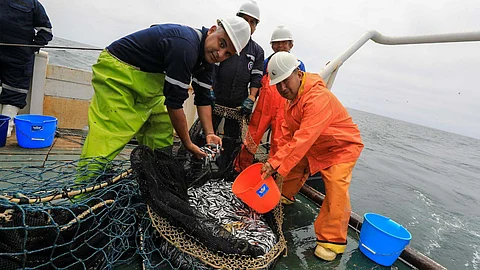

The anchovy fishing season will guarantee the employment of more than 49 thousand workers associated with this species' production chain in Peru.
Photo: Produce.
Between November 1st and December 31st, the accumulated anchovy landings in the north-central zone of Peru reached 1,955,571 tons. According to the Peruvian Ministry of Production (Produce), this figure represents 77.91% of the quota allocated for the second fishing season 2024, which was 2.51 million tons.
"These figures reflect the Ministry of Production's commitment to the conservation and responsible management of Peru's hydrobiological resources. Through constant monitoring and the implementation of strict regulations, we seek to balance productivity with sustainability, ensuring the preservation of the marine ecosystem for future generations," Produce said in a statement.
In setting its fishing quotas, Peru's fishing authority follows the scientific recommendations of the Peruvian Institute of the Sea (Imarpe). Thanks to these practices, the country was recognized last summer as one of the best-managed fisheries in the world.
Anchovy fishing is one of the most important pillars of the Peruvian economy, not only for its contribution to the Gross Domestic Product (GDP) - fishery exports exceeded USD 3 billion from January to September - but also for its positive impact on local communities and the generation of direct and indirect employment.
At the end of October, Produce's announcement on the start of the second anchovy season specifically put the amount of the contribution to GDP at a total of USD 1,349 million (EUR 1,250 million) in foreign exchange and explained this figure will have an impact on 0.8% of the GDP, and 8% of national exports in 2024. In addition, it will ensure the employment of more than 49 thousand workers associated with the anchovy production chain.
Produce reported that there are currently 238 vessels in the fishing zone, distributed in the regions off La Libertad, Ancash, and Lima.
Likewise, it also said that the main ports where landings took place were Chimbote, Malabrigo, Coishco, Callao, Tambo de Mora, Supe, and Chancay, while the principal processing plants receiving the resource were TASA (22%), COPEINCA (19%), Exalmar (17%), Diamante (11%), and Hayduk (9%).
All of the above figures underscore the Peruvian industrial fleet continuous effort in the capture and processing of this strategic resource and consolidate the sector as a key driver of the country's economic development.
However, in addition to its economic importance, the Peruvian anchovy fishery is also fundamental for global food security as it is one of the main sources for the production of fishmeal and fish oil used in animal and human nutrition, where, historically, it has accounted for an average of 20% of world production.
According to statistics from the International Fishmeal and Fish Oil Organization (IFFO), during the first half of 2024, cumulative fishmeal production increased by almost 36% compared to the same period in 2023, driven mainly by Peru's first anchovy season, closed with more than 98% of the quota caught.
The Peruvian Ministry of Production said the next few weeks will be decisive to reach the total quota allocated in the second season, consolidating Peru as a world leader in anchovy production.
